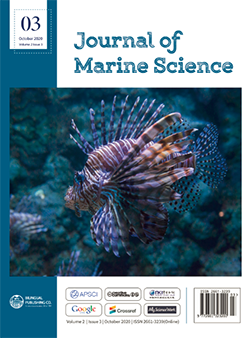Study on Mooring Design and Calculation Method of Ocean Farm Based on Time-Domain Potential Flow Theory
DOI:
https://doi.org/10.30564/jms.v2i3.2018Abstract
In order to calculate the mooring force of a new semi-submerged Ocean Farm quickly and accurately, based on the unsteady time-domain potential flow theory and combined the catenary model, the control equation of mooring cable is established, and the mooring force of the platform under the wave spectrum is calculated. First of all, based on the actual situation of the ocean environment and platform, the mooring design of the platform is carried out, and the failure analysis and sensitivity analysis of the single anchor chain by the time domain coupling method are adopted: including different water depth, cycle, pretension size, anchor chain layout direction and wind speed, etc. The analysis results confirm the reliability of anchoring method. Based on this, the mooring point location of the platform is determined, the force of each anchor chain in the anchoring process is calculated, and the mooring force and the number of mooring cables are obtained for each cable that satisfies the specification, the results of this paper can provide theoretical calculation methods for mooring setting and mooring force calculation of similar offshore platforms.
Keywords:
Ocean Farm, Wave Load, Mooring force, Potential flow theoryReferences
[1] T. Nakajima, S. Motora, M. Fujino. On the dynamic analysis of multicomponent mooring lines. Proceedings 14th Annual Offshore Technology Conference, 1982: 105-120.
[2] S Huang.Dynamic analysis of three-dimensional marine cables. Ocean Engineering, 1994, 21(6): 587- 605.
[3] A. M. Grosenbaug. A simple model for heave-induced dynamic tension in catenary moorings. Applied Ocean Research, 2001, 23: 159-174.
[4] D. L. Garrett. Coupled analysis of floating production systems. Ocean Engineering, 2005, 32(7): 802-816.
[5] A.Tahar, M. H. Kim. Coupled-dynamic analysis of floating structures with polyester mooring lines. Ocean engineering, 2008, 35(17): 1676-1685. [6] K. K. Boo. Stability analysis and design of spread mooring systems. Dissertation, the University of Michigan, 1999.
[6] J. E.W. Wichers. Wave-current Interaction Effects on Moored Tankers in High Seas. Offshore Technology Conference, 5631, Houston, 2008.
[7] Q. Q. Shi, J. M. Yang. Study on the characteristics of semi-submersible platform motion and mooring system. Marine Engineering, 2010, 4(1): 1-8. (in Chinese)
[8] J. Huang, K. Q. Zhu. Static analysis and comparison of two kinds of mooring systems for semi-submersible platform, 2004, 18(3). (in Chinese)
[9] S.L. Zhou, W. Nie, Y. Bai. Research on the design of the mooring system of deep water semi-submersible platform. Ship Mechanics, 2010, 14(5): 495-502. (in Chinese)
[10] B. Tong, J. M. Yang, X. Li. Study on dynamic characteristics of mooring system of deep water semi-submersible platform. Ocean engineering, 2009, 27(1): 1-7. (in Chinese)
[11] Y. L. Fan, B. S. Wu, Q. M. Miao. Effect of tension mooring on performance of deep-water semi-submersible platform. China Offshore Platform, 2010, 25(3): 41-46. (in Chinese)
[12] Q. Sun, G.S. Peng, Q.H. Dong. Design and analysis of catenary single point mooring system- Papers on Green Shipbuilding and Shipping Forum. China Association for Science and Technology,The People's Government of Yunnan Province, 2014, 6. (in Chinese)
[13] Arcandra. Hull/mooring/riser coupled dynamic analysis of a deep-water floating platform with polyester lines. Texas A&M University, 2001.
[14] Y. G. Tang, S. X. Zhang, R. Y. Zhang. Research progress on dynamic characteristics of deep-sea mooring system. Ocean engineering, 2008, 26(1): 120-126. (in Chinese)
Downloads
Issue
Article Type
License
Copyright and Licensing
The authors shall retain the copyright of their work but allow the Publisher to publish, copy, distribute, and convey the work.
Journal of Marine Science publishes accepted manuscripts under Creative Commons Attribution-NonCommercial 4.0 International License (CC BY-NC 4.0). Authors who submit their papers for publication by Journal of Marine Science agree to have the CC BY-NC 4.0 license applied to their work, and that anyone is allowed to reuse the article or part of it free of charge for non-commercial use. As long as you follow the license terms and original source is properly cited, anyone may copy, redistribute the material in any medium or format, remix, transform, and build upon the material.
License Policy for Reuse of Third-Party Materials
If a manuscript submitted to the journal contains the materials which are held in copyright by a third-party, authors are responsible for obtaining permissions from the copyright holder to reuse or republish any previously published figures, illustrations, charts, tables, photographs, and text excerpts, etc. When submitting a manuscript, official written proof of permission must be provided and clearly stated in the cover letter.
The editorial office of the journal has the right to reject/retract articles that reuse third-party materials without permission.
Journal Policies on Data Sharing
We encourage authors to share articles published in our journal to other data platforms, but only if it is noted that it has been published in this journal.




 Baoji Zhang
Baoji Zhang

